 W
WAnarosaurus is an extinct genus of pachypleurosaurs that lived in the Middle Triassic period (Anisian) and has been found in the Jena Formation and the Karlstadt Formation of Germany and the Winterswijk Quarry of The Netherlands. Two species are known: A. pumilio and A. heterodontus. The holotype of A. pumilio was originally housed at the Institut und Museum fur Geologie und Palaontologie, Georg-August-Universitat, Gottingen, but can no longer be located today because it was lost or destroyed during World War II.
 W
WAttenborosaurus is an extinct genus of pliosaurid from the Early Jurassic of Dorset, England. The type species is A. conybeari. The genus is named after David Attenborough, the species after William Conybeare.
 W
WBishanopliosaurus is a genus of plesiosaur. The type species is B. youngi, based on remains found in the Ziliujing Formation of China.
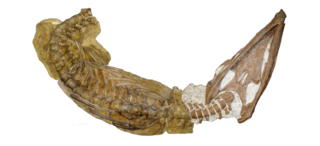 W
WBrachauchenius is an extinct genus of pliosaurid that lived in North America during the Late Cretaceous.
 W
WCrymocetus is an extinct genus of plesiosaur from the Cretaceous Chalk Group of Sussex, England. Since its description, it has been seldom examined by subsequent authors, except when mentioned in discussions of Cretaceous plesiosaurs
 W
WCryptoclidia is a clade of plesiosaurs.
 W
WCryptoclididae is a family of medium-sized plesiosaurs that existed from the middle Jurassic to the early Cretaceous period. They had long necks, broad and short skulls and densely packed teeth. They fed on small soft-bodied preys such as small fish and crustaceans.
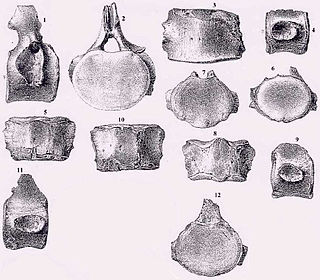 W
WDiscosaurus is an extinct genus of Cretaceous plesiosaur first discovered in Alabama by Joseph Leidy. It was argued to be the same animal as Elasmosaurus.
 W
WEdgarosaurus is a genus of polycotylid plesiosaur from the Thermopolis Shale, containing one species, E. muddi. The type specimen was found in Early Cretaceous rocks in the state of Montana in the United States. At the time, this location was covered by part of the Western Interior Seaway. Edgarosaurus was one of the first polycotylids that evolved to become native to the Western Interior Seaway.
 W
WEretmosaurus is an extinct genus of plesiosaur.
 W
WFutabasaurus is a genus of plesiosaur from the Late Cretaceous of Fukushima, Japan. It was described and named in 2006, and was assigned to the family Elasmosauridae. The genus contains one species, F. suzukii.
 W
WHanosaurus is an extinct genus of pachypleurosaurs that existed during the Triassic period in what is now China. It was described by Young in 1972, and the type species is Hanosaurus hupehensis.
 W
WHydrorion is an extinct genus of plesiosaur. It was found in Jurassic formations in Germany to Posidonia Shale formation.
 W
WHydrotherosaurus is an extinct genus of elasmosaurid plesiosaur from the Upper Cretaceous of Fresno County, California, USA. The only known species, H. alexandrae, was named for its discoverer, Annie Montague Alexander, by Samuel Paul Welles.
 W
WLeptocleidia is a clade of plesiosauroids. The group was erected in 2007 as Leptocleidoidea. Although established as a clade, the name Leptocleidoidea implies that it is a superfamily. Leptocleidoidea is placed within the superfamily Plesiosauroidea, so it was renamed Leptocleidia by Hilary F. Ketchum and Roger B. J. Benson (2010) to avoid confusion with ranks. Leptocleidia is a node-based taxon which was defined by Ketchum and Benson as "Leptocleidus superstes, Polycotylus latipinnis, their most recent common ancestor and all of its descendants".
 W
WLeptocleididae is a family of small-sized plesiosaurs that lived during the Early Cretaceous period. Leptocleidus and Umoonasaurus had round bodies and triangle-shaped heads. Hilary F. Ketchum and Roger B. J. Benson (2010), transferred Brancasaurus, Kaiwhekea, Nichollssaura and Thililua to this family. However, Ketchum and Benson (2011) reassigned Kaiwhekea and Thililua to their original positions, as an elasmosaurid and a polycotylid, respectively.
 W
WLibonectes is an extinct genus of sauropterygian reptile belonging to the plesiosaur order. It is known from specimens found in the Britton Formation of Texas (USA) and the Akrabou Formation of Morocco, which have been dated to the lower Turonian stage of the late Cretaceous period.
 W
WMacroplata is an extinct genus of Early Jurassic rhomaleosaurid plesiosaur which grew up to 4.5 metres (15 ft) in length. Like other plesiosaurs, Macroplata probably lived on a diet of fish, using its sharp needle-like teeth to catch prey. Its shoulder bones were fairly large, indicating a powerful forward stroke for fast swimming. Macroplata also had a relatively long neck, twice the length of the skull, in contrast to pliosaurs.
 W
WManemergus is a genus of polycotylid plesiosaur from the Late Cretaceous (Turonian) of Morocco. Manemergus was described in 2005 and contains only one species, M. anguirostris. The type specimen was discovered close to the town of Goulmima (Tizi-n-Imnayen) in Morocco's High Atlas mountains, in the same locality as another polycotylid, Thililua, was discovered.
 W
WMegalneusaurus is an extinct genus of large pliosaur that lived in the Sundance Sea during the Kimmeridgian, ~156-152 million years ago, in the Late Jurassic. It was named by paleontologist W. C. Knight in 1895.
 W
WMeyerasaurus is an extinct genus of rhomaleosaurid known from Holzmaden, Baden-Württemberg of southwestern Germany.
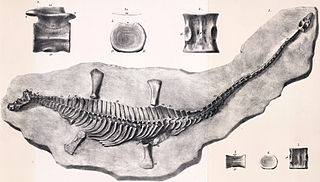 W
WMicrocleidus is an extinct genus of sauropterygian reptile belonging to the Plesiosauroidea. It was about the size of a medium-sized dolphin, reaching a length of 3 metres (9.8 ft). The species has 40 neck vertebrae and a short tail of 28 vertebrae. Fossils of the genus have been found in France, the Posidonia Shale in Germany and the Alum Shale Formation of England.
 W
WNichollssaura is an extinct genus of leptocleidid plesiosaur from the Early Cretaceous Boreal Sea of North America. The type species is N. borealis, found in the early Albian age Clearwater Formation near Fort McMurray, Alberta, Canada. Nichollssaura fills an approximate 40-million-year gap in the fossil record of North American plesiosaurs.
 W
WOdoiporosaurus is an extinct genus of pachypleurosaur known from the Middle Triassic Besano Formation (Grenzbitumenzone) of northern Italy. It contains a single species, Odoiporosaurus teruzzii. Odoiporosaurus is the sister taxon of the group formed by Serpianosaurus and Neusticosaurus, and together with the older and more primitive Dactylosaurus plus Anarosaurus clade, they form a monophyletic group of European pachypleurosaurids.
 W
WOpthalmothule, was a cryptoclidid plesiosaur dating to the latest Volgian, found in the Slottsmøya Member Lagerstätte of the Agardhfjellet Formation in Spitsbergen. The type species is O. cryostea.
 W
WPachycostasaurus is an extinct Pliosauroid from the Oxford Clay formation of Peterborough, England.
 W
WPolycotylidae is a family of plesiosaurs from the Cretaceous, a sister group to Leptocleididae.
 W
WPolyptychodon is a genus of pliosaurid found Middle-Late Cretaceous marine deposits in southern England and Patagonia. It has been considered a nomen dubium in a 2016 review.
 W
WRhaeticosaurus is an extinct genus of basal pliosauroid from the Late Triassic (Rhaetian) rocks of the Exter Formation. The type and only species, Rhaeticosaurus mertensi, was named by Tanja Wintrich in 2017. It is known from a partial articulated skeleton.
 W
WSeeleyosaurus is an extinct genus of plesiosaur. It is known from a large almost complete skeleton from the Upper Lias (Toarcian) of Württemberg, Germany. There seems to be the impression of a rhomboidal flap of skin in a vertical plane; if so, many plesiosaurs may have been equipped in this way. The holotype was destroyed in 1945 (WWII) and only a cast exists today. A second specimen, preserved in 3D, has survived until today.
 W
WSthenarosaurus is an extinct genus of rhomaleosaurid pliosauroid discovered in the Toarcian-aged 'Main Alum Shale' in Whitby, England. The type species, S. dawkinsi, was named and described in 1909. The type specimen is MMUM LL 8023, a set of postcrania discovered in Whitby. Other indetermiante specimens are known, including a pectoral girdle described in 1911.
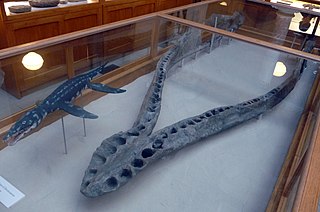 W
WThalassophonea is an extinct clade of pliosaurids from the Middle Jurassic to the early Late Cretaceous of Australia, Europe, North America and South America. Thalassophonea was erected by Roger Benson and Patrick Druckenmiller in 2013. The name is derived from Greek thalassa (θάλασσα), "sea", and phoneus (φονεύς), "murderer". It is a stem-based taxon defined as "all taxa more closely related to Pliosaurus brachydeirus than to Marmornectes candrewi".
 W
WTricleidus is an extinct genus of cryptoclidid plesiosaur known from only specimen from the middle Jurassic of United Kingdom. It was first named by Andrews in 1909 and the type species is Tricleidus seeleyi.
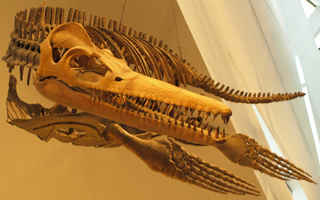 W
WTrinacromerum is an extinct genus of sauropterygian reptile, a member of the polycotylid plesiosaurs. It contains two species, T. bentonianum and T. kirki. Specimens have been discovered in the Late Cretaceous fossil deposits of what is now modern Kansas and Manitoba.
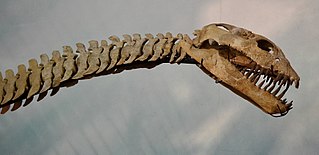 W
WZarafasaura is an extinct genus of elasmosaurid known from the Oulad Abdoun Basin of Morocco.